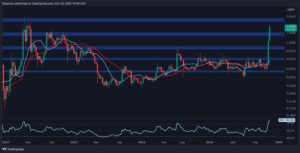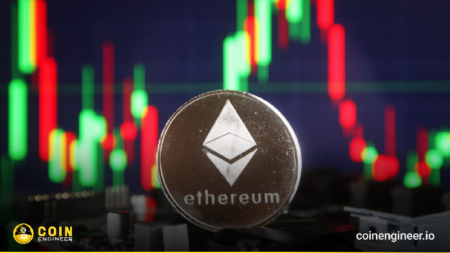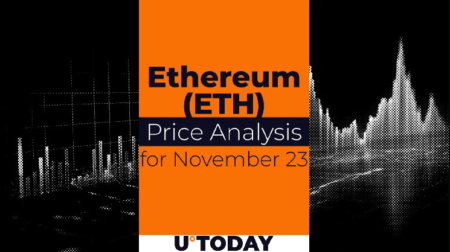ETH monetary policy is just like WWE
The fighting in pro wrestling is largely fake and the outcomes are mostly pre-determined.
But much of the appeal for fans is that they, as a whole, can influence characters and storylines over the course of years — even who holds the World Championship belt.
Take Dwayne Johnson, perhaps better known as The Rock. The WWE (then the WWF, back in 1996) first played Johnson as “Rocky Maivia,” combining ring names of his real-life father and grandfather who were wrestling legends in their own right.
The Rocky Maivia character was a clean cut babyface nicknamed “The Blue Chipper” — wrestling’s first third generation star who could do no wrong. Except, the crowd hated Rocky, despite the Federation’s attempts to build the character up with Intercontinental Championship wins and defenses against fan favorites HHH and Bret Hart.
Rocky was harassed with chants of “Rocky sucks” and “die, Rocky, die” for so long that a decision was made to let the character turn “heel” — switch him into a villain — by joining the bad-guy faction Nation of Domination, referring to himself in the third person and having the character spend much of his promo time in-ring insulting the crowd and everyone else.
The fans themselves had made The Rock, working in organic symbiosis with WWF writers to shape the character arc, and ultimately Johnson’s career.
Ethereum’s relationship with the crypto ecosystem is really quite similar. The Ethereum Foundation, of which project co-founder Vitalik Buterin is one of three board members, has pitched repeated changes to ETH’s monetary policy over the years, generally on account of what’s playing out in real time across the Ethereum economy.
In 2017, when Ethereum still ran on a consensus algorithm powered by proof-of-work, a proposal jointly written by Buterin and long-time contributor Afri Schoedon was enacted to cut block rewards from 5 ETH to 3 ETH — a 40% reduction.
The price of ether had gone from $1 when it launched in August 2015 to over $200 by mid-2017, while block rewards had stayed the same. This led the Ethereum economy to overpay for security, with miners earning far more dollar value per block than they spent on electricity and other overheads. It’s much fairer for Ethereum users to pay the minimum-viable fee.
Another proposal was pushed through two years later to slash the block reward further, by 33%, down to 2 ETH. Those were monetary policy changes made in response to the price of ether, itself an extension of market sentiment.
Read more: Cheatsheet: Ethereum on track to burn more than $10B ETH over next year
More fundamental changes to Ethereum’s monetary policy occurred in the following years, also reflective of what was happening in the wild. In 2021, a fee burn mechanism sought to mitigate risks associated with miners gauging Ethereum users with MEV tactics, and also opened the door for ETH’s supply to turn deflationary after the Merge under certain conditions.
Ethereum’s issuance was then cut by 90% as it transitioned to proof of stake in 2022, which made sense considering the cost of running validator nodes is a fraction of the cost of running crypto mining rigs. Rewards were placed on a sliding scale based on how many validators were staked on the network — the more validators there are, the less ETH yield there will be.
Now, Ethereum Foundation researchers are back with another proposal: reduce ETH issuance in such a way that it discourages stakers, which have so far locked up almost 27% of the current circulating supply. All those validators must be paid yield, which would eventually dilute ETH holders, leading them to once again overpay for security.
As it stands, there are enough validators securing the network, the thinking goes, and the ever-rising popularity of liquid staking tokens could threaten ETH’s position as the blockchain’s cryptocurrency. ETH must be made more valuable to encourage holders not to stake their ETH. Reducing issuance to increase scarcity is one way to do it.
The Ethereum Foundation researchers were much like WWF story writers when they debuted babyface Rocky Maivia: fairly sure the response would be positive but probably surprised by the negative response from the crowd — which is now worried over its lack of power over monetary policy.
Better start chanting.
— David Canellis
Data Center
- There’s now more than 1 million validators on Ethereum, with a total stake of 32.28 million ETH ($114.14 billion).
- Less than half that (15.44 million ETH) is locked up in Ethereum DeFi, up 7% since the start of April.
- Base’s TVL is the fastest growing for chains with over $300 million, now at $1.56 billion after gaining 26% in the past week.
- Ahead of the halving next week, bitcoin’s holding on to $70K, just $3K shy of its all-time high according to Coinbase.
- Bitcoin Cash, which went through its halving last week, has since shed gains and is down 11% to $600 in the last seven days.
Can the Wild West be tamed?
Speaking of Ethereum…BlackRock’s continued foray into crypto may hit some complications if the Securities and Exchange Commission decides to declare ETH a security.
Not only does BlackRock have a standing application for an ETH ETF, which has not yet been approved by the SEC, but the firm launched its first tokenized fund on Ethereum last month.
All of this is based on reports that Gary Gensler’s agency is mulling ETH as a security after special purpose broker dealer Prometheum announced that it would offer custodial services for ETH.
Read more: Ether is the Schrödinger’s cat of crypto
Obviously, a security designation would make a path to the ether ETFs more complicated, though BlackRock CEO Larry Fink told Fox Business in March that he thinks an ETH ETF would still be possible.
Van Buren Capital general partner Scott Johnsson noted that if Gensler and the SEC decided to go “nuclear” and label ETH as a security, it could “kill” the ETH ETF app and potentially put a stop to both BUIDL and the firm’s tokenization efforts.
The designation would only block a potential ETH ETF, Johnsson noted, but BUIDL would basically be taken away from BlackRock and Fink.
“[Gensler] can stop the [ETH ETF without] going nuclear,” he added.
Read more: CFTC calls ETH a commodity in KuCoin complaint
Johnsson explained to Blockworks that BUIDL is at risk because those using the fund would need to use ETH for gas.
“Depending on the specifics of the SEC’s theory of ETH as a security, it’s not clear how ETH as [a] gas token could be characterized or used to facilitate those transfers without potentially running afoul of engaging” with an unregistered security,” he told Blockworks.
While BUIDL is a fairly tame play in the space, it shows how crypto is being treated — at least by some regulators — as a legal thought experiment, which can be risky for firms trying to expand their interests in the space.
And, no, it doesn’t matter if it’s BlackRock or Coinbase.
— Katherine Ross
SDNY: Crypto’s hottest club
Another crypto case is underway in New York. This time it’s Avraham “Avi” Eisenberg’s criminal trial.
Prosecutors say the 28-year-old crypto trader illegally manipulated markets when he made off with $110 million in October 2022 following a series of trades on DeFi trading operation Mango Markets. Eisenberg has been charged with commodities fraud, commodities manipulation and wire fraud.
His defense team said this week that it’s all a big misunderstanding. Eisenberg just made some good trades. Plus, he had $13 million on the line. It’s not his fault he wasn’t required to submit personal information or that Mango didn’t run a credit check, the argument goes.
Read more: Bankman-Fried’s legal team argues for leniency, citing philanthropy and character
Hopping on a plane out of the country right after the alleged heist — which, surprise, is exactly what Eisenberg did — will be harder to explain to the jury.
In all seriousness, Eisenberg’s defense (at least based on what we heard during opening statements) rests on the idea that if the code allowed for something to happen, then it can’t be illegal. Eisenberg was just “using the protocol as designed,” he said in October 2022, days after completing the transactions.
Eisenberg may not be the most popular defendant, but the US government’s allegations, if proven true, could impact a lot of the activities traders today enjoy. Like using anonymous accounts and skirting know-your-customer (KYC) requirements. It’s a case a lot of the industry probably will want to watch.
When the criminal proceedings wrap, Eisenberg has a slew of civil suits waiting for him. The SEC, CFTC and Mango Labs all filed cases, which are on hold for now.
— Casey Wagner
The Works
- Hong Kong could approve spot bitcoin and ether ETFs as soon as Monday, Bloomberg reports.
- Ex-FTX CEO Sam Bankman-Fried filed to appeal his fraud conviction and 25-year prison sentence.
- The delisting of privacy coins continued after Kraken pulled Monero in Ireland and Belgium.
- Blockchain analytics unit TRM Labs tapped a former INTERPOL president as a senior advisor.
- BUIDL holders can now transfer shares of BlackRock’s fund to receive USDC, Circle announced.
The Morning Riff
Talk about regulatory whiplash.
Even as it battles the SEC in an open court battle, US crypto exchange Coinbase is apparently earning plaudits from the Financial Crimes Enforcement Network.
Yes, FinCEN sent Coinbase a letter to “recognize” the exchange’s “substantial contributions” to an internal award-winning investigation. Thanks for being part of the team, the letter basically says.
Read more: Coinbase class action lawsuit gets partial revival
In a way, this letter sums up the regulatory picture in America today. On the one hand, Coinbase is allegedly breaking every rule imaginable in the eyes of the SEC. But for FinCEN, Coinbase is a critical player, helping its team rack up literal points on the anti-money laundering scoreboard.
Meanwhile, Congress — ostensibly the ones who might be able to provide an iota of clarity — is preparing to jettison a House Speaker for the second time in history.
Well, at least Coinbase has something to pin on the fridge in the staff break room.
— Michael McSweeney
Read the full article here









